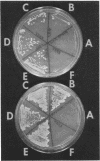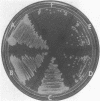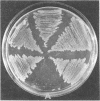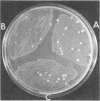Abstract
The availability of a strain of Acinetobacter competent for transformation has made it possible to demonstrate the genetic relatedness of a large variety of gram-negative, oxidase-negative, nonmotile, and aerobic coccobacilli originally classified into eleven different genera. Deoxyribonucleic acid (DNA) species from 265 such strains are capable of transforming stable auxotrophs of the competent Acinetobacter to prototrophy. The compositions of these DNA species vary from 40 to 46.8% guanine plus cytosine. Strains with widely differing phenotypic properties are also included in this collection of acinetobacters. DNA species from all oxidase-positive strains of Moraxella and from a variety of common bacteria are unable to transform the competent Acinetobacter. Although acinetobacters are usually considered to be unable to reduce nitrate to nitrite, six strains known to carry out this reduction have been shown to be authentic acinetobacters since their DNA species readily transform the competent Acinetobacter auxotrophs to prototrophy. In contrast to previous findings that acinetobacters rarely grow with glucose as a sole carbon source, the results of the present study show that 17 of the 265 strains grow readily in a glucosemineral medium, and 48 other strains can mutate spontaneously to grow in such a medium. A second competent strain of Acinetobacter, originally unable to use glucose, d-xylose, or d-ribose as carbon sources, has been transformed for ability to dissimilate these compounds using DNA species from strains that normally grow on these sugars. Although most of the 265 Acinetobacter strains studied were originally grown on complex media when isolated from human sources, only nine of these strains require growth factors in order to grow in a mineral medium containing a single carbon and energy source. A simple transformation assay has been devised for rapid examination of large numbers of strains to determine whether or not they are acinetobacters. This assay, which is suitable for routine diagnostic work, includes a procedure for preparation of crude transforming DNA from a small quantity of bacterial paste. Samples of DNA prepared from Acinetobacter cultures that had died on slants and plates were still able to effect transformation of the competent auxotrophs to prototrophy.
Full text
PDF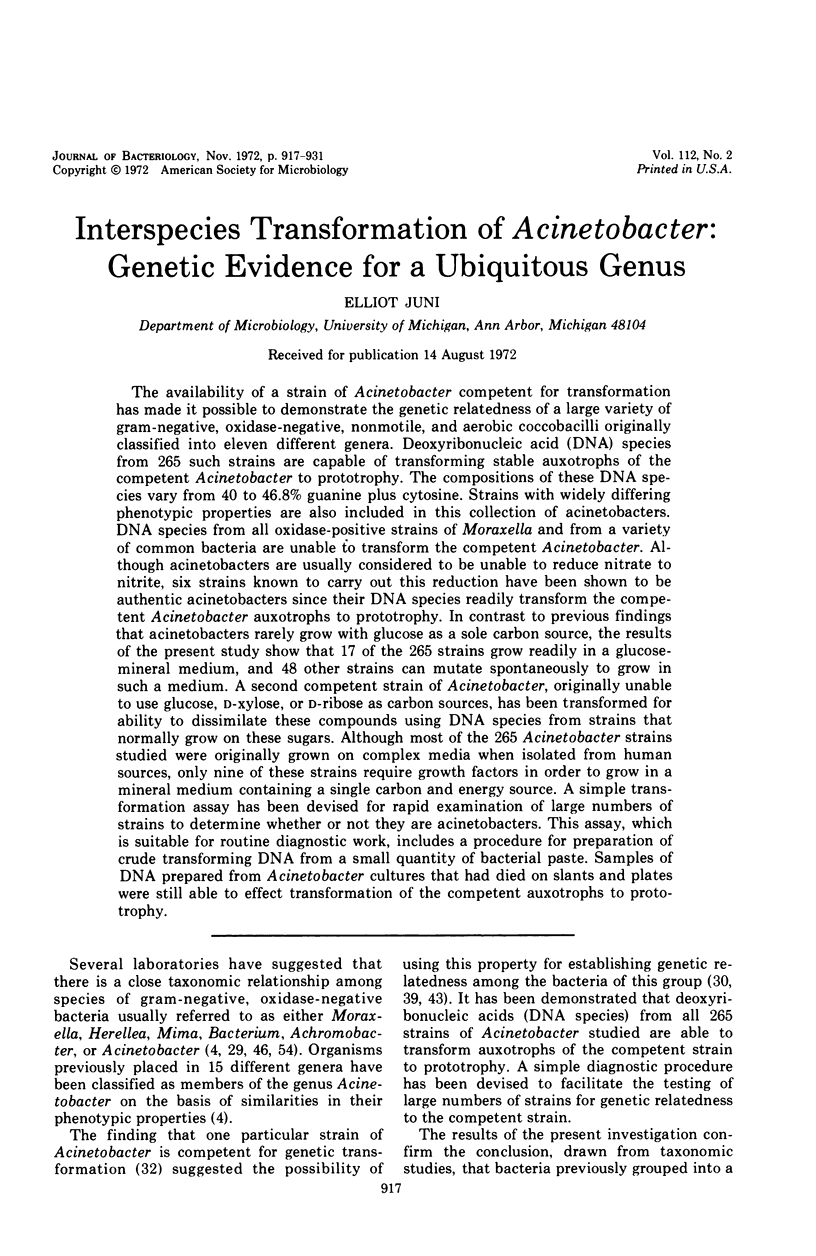
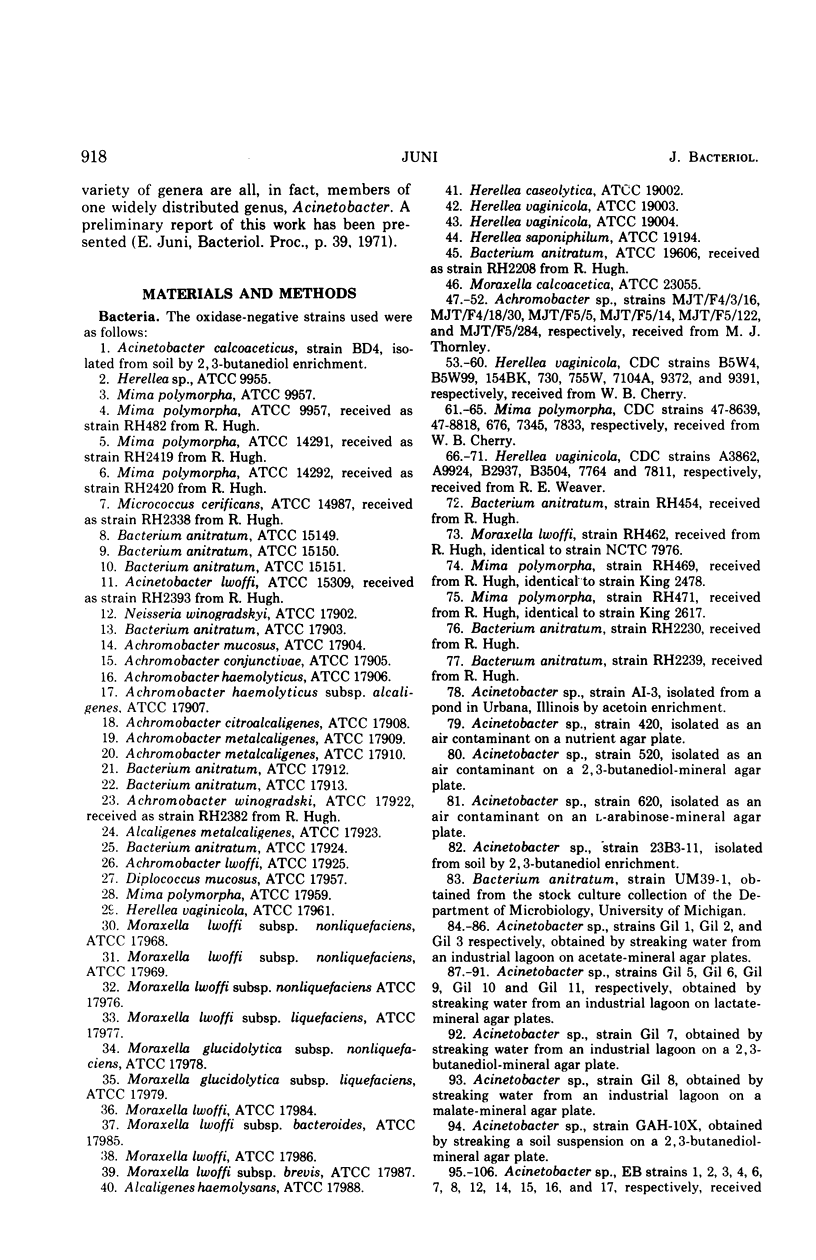
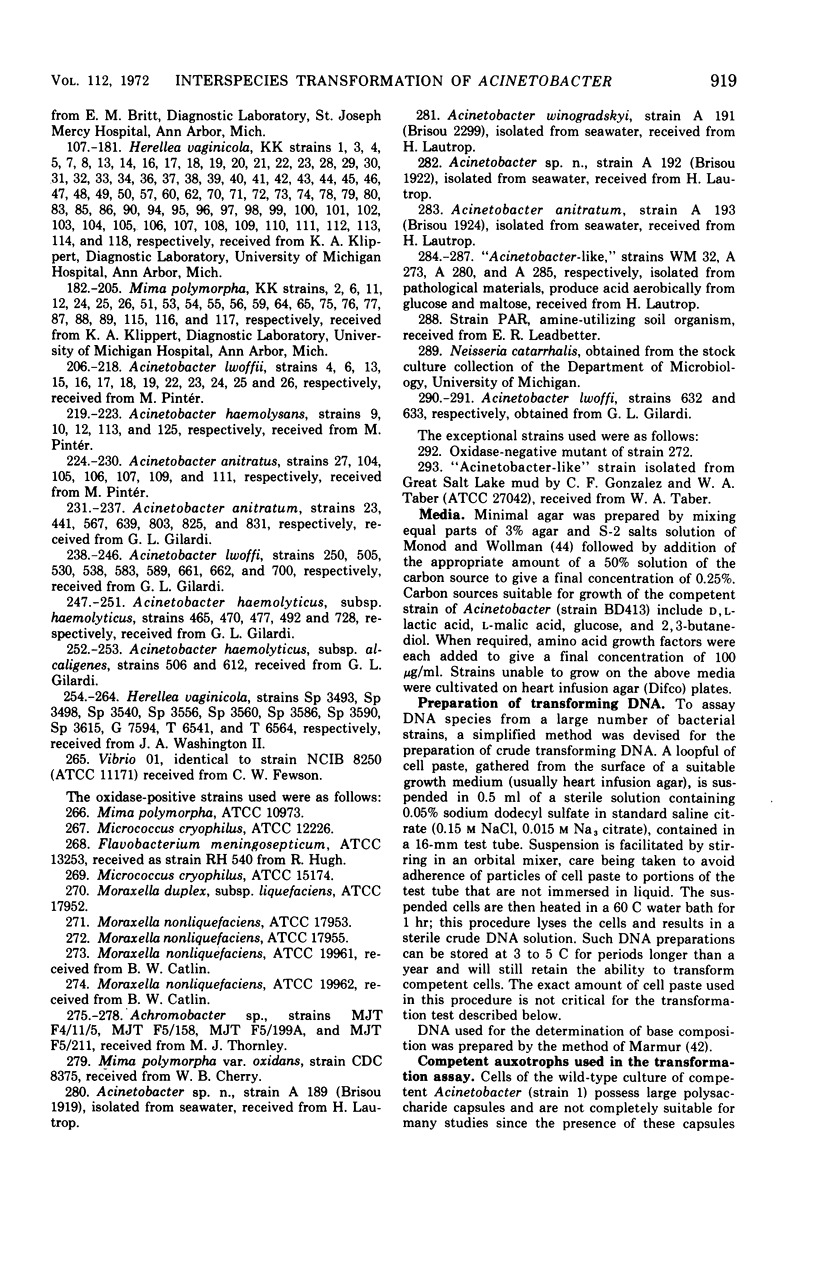
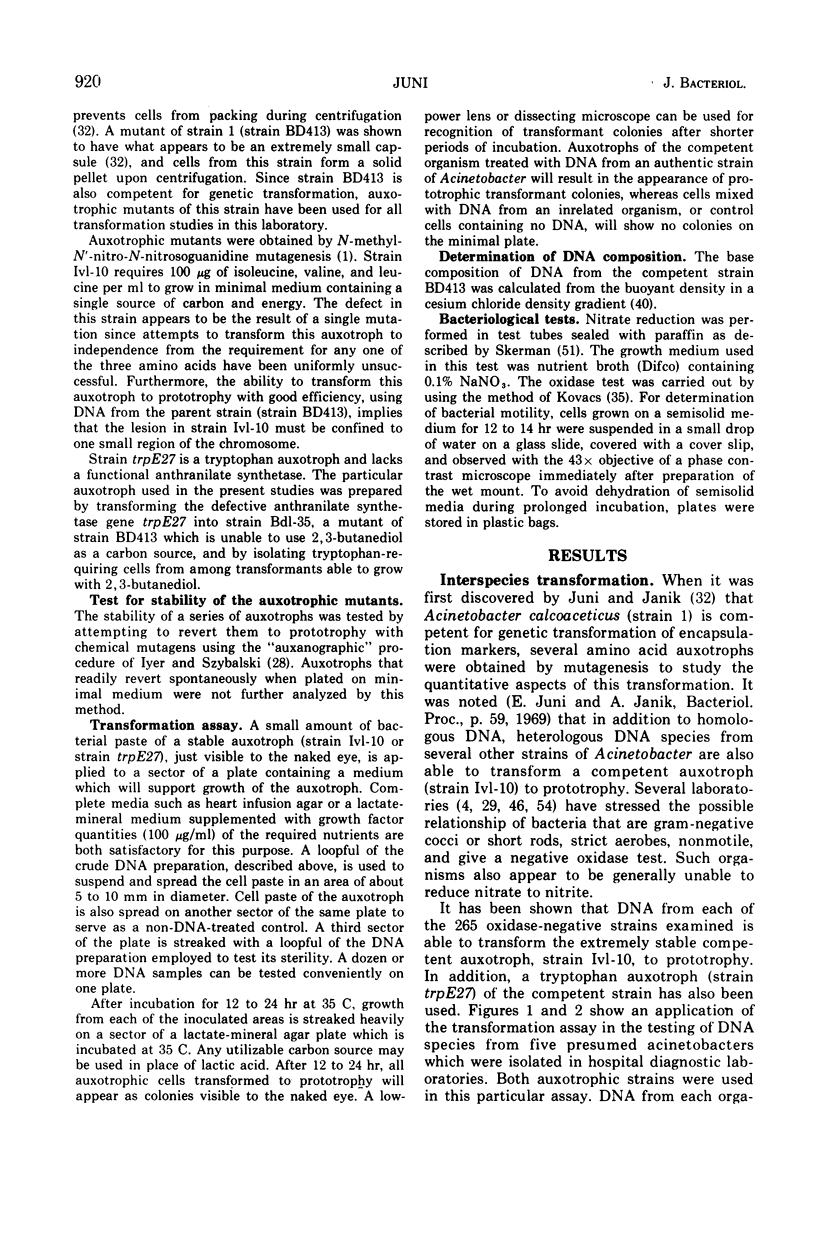
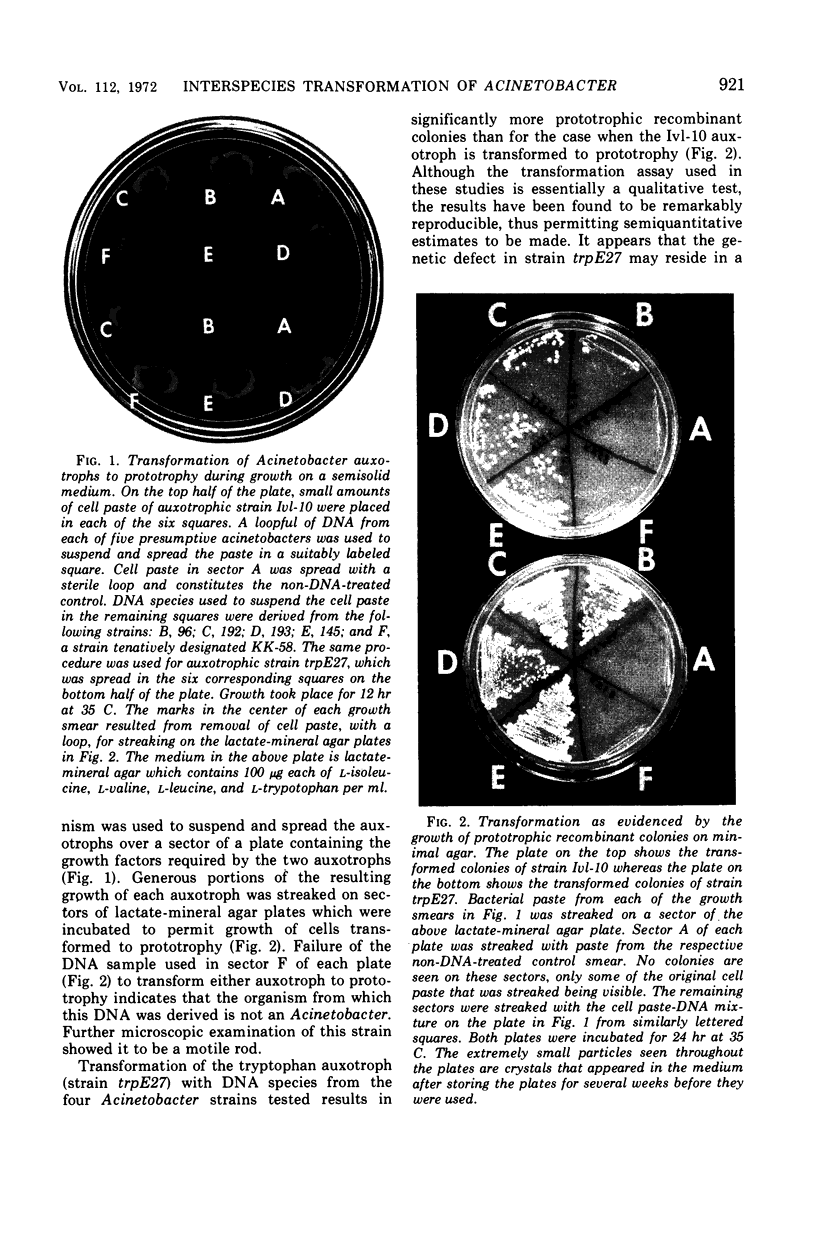
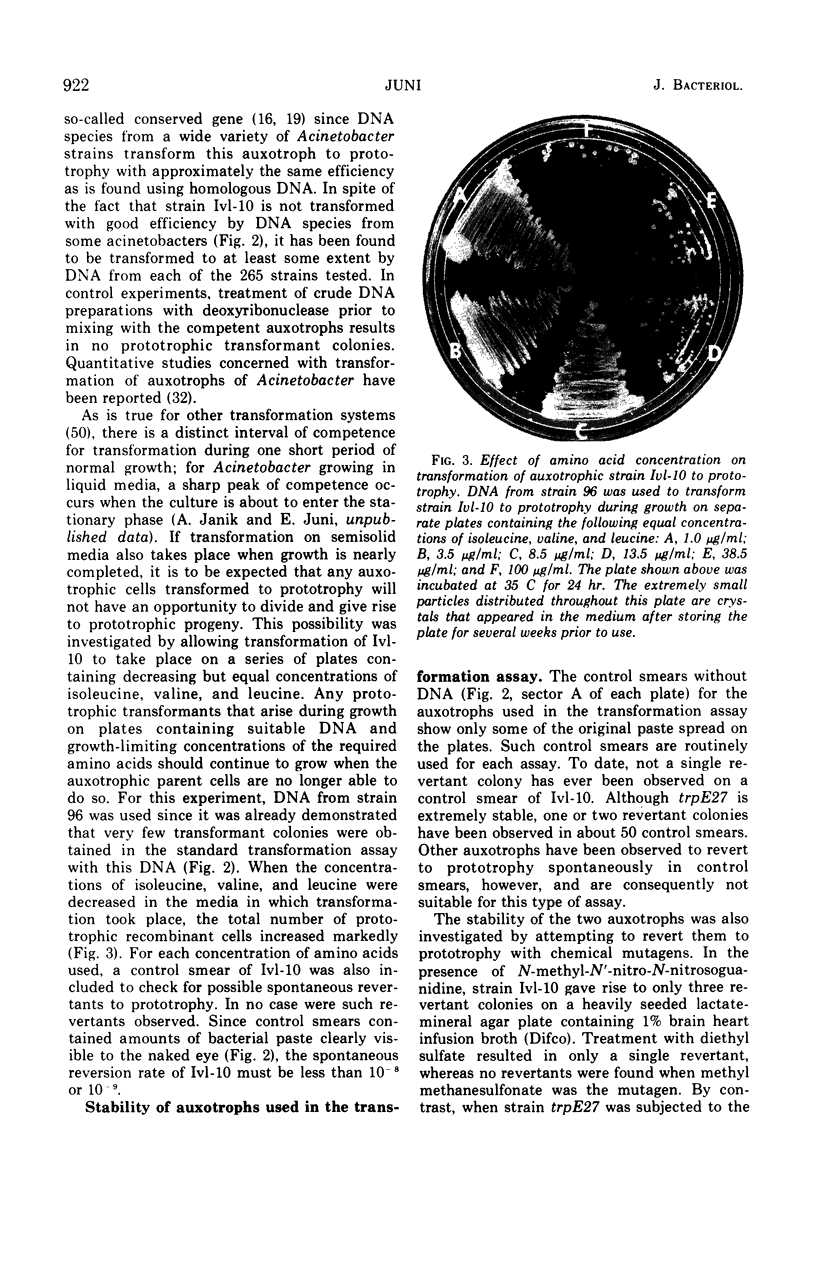
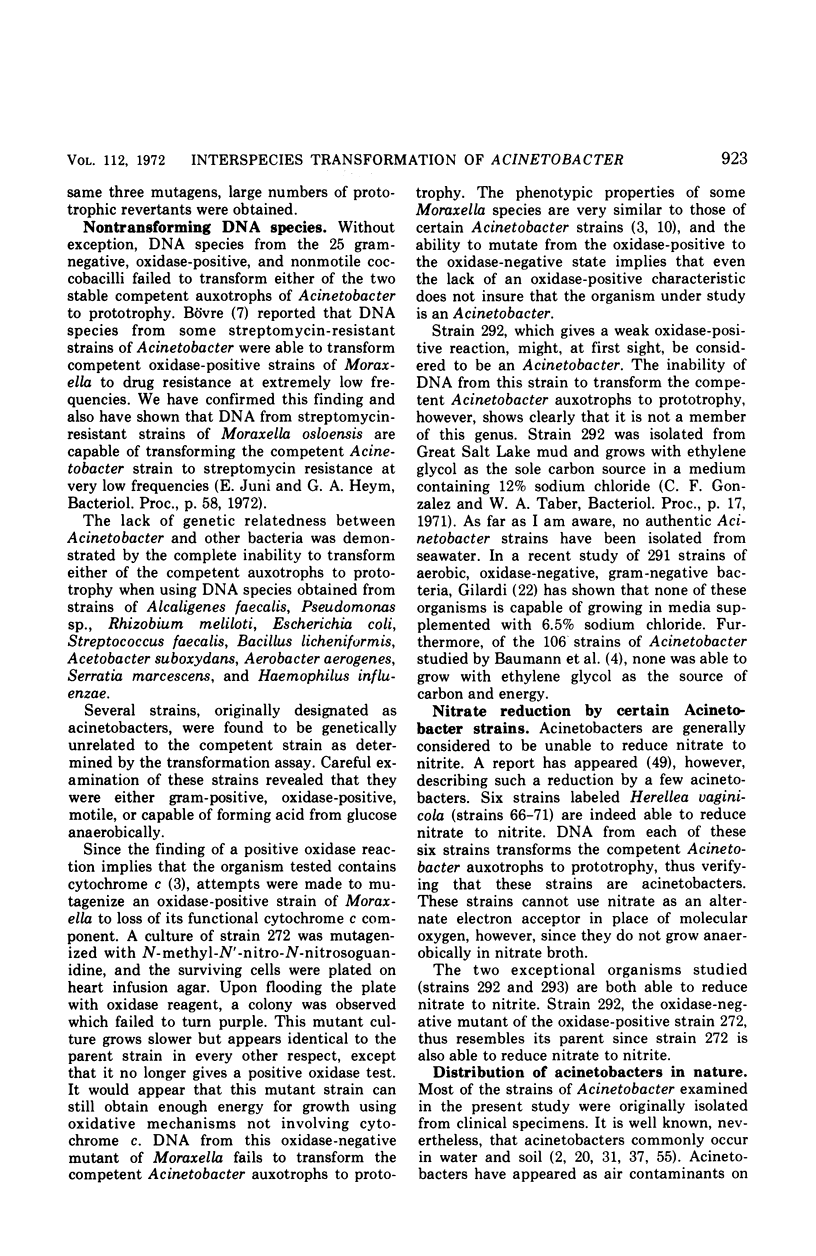
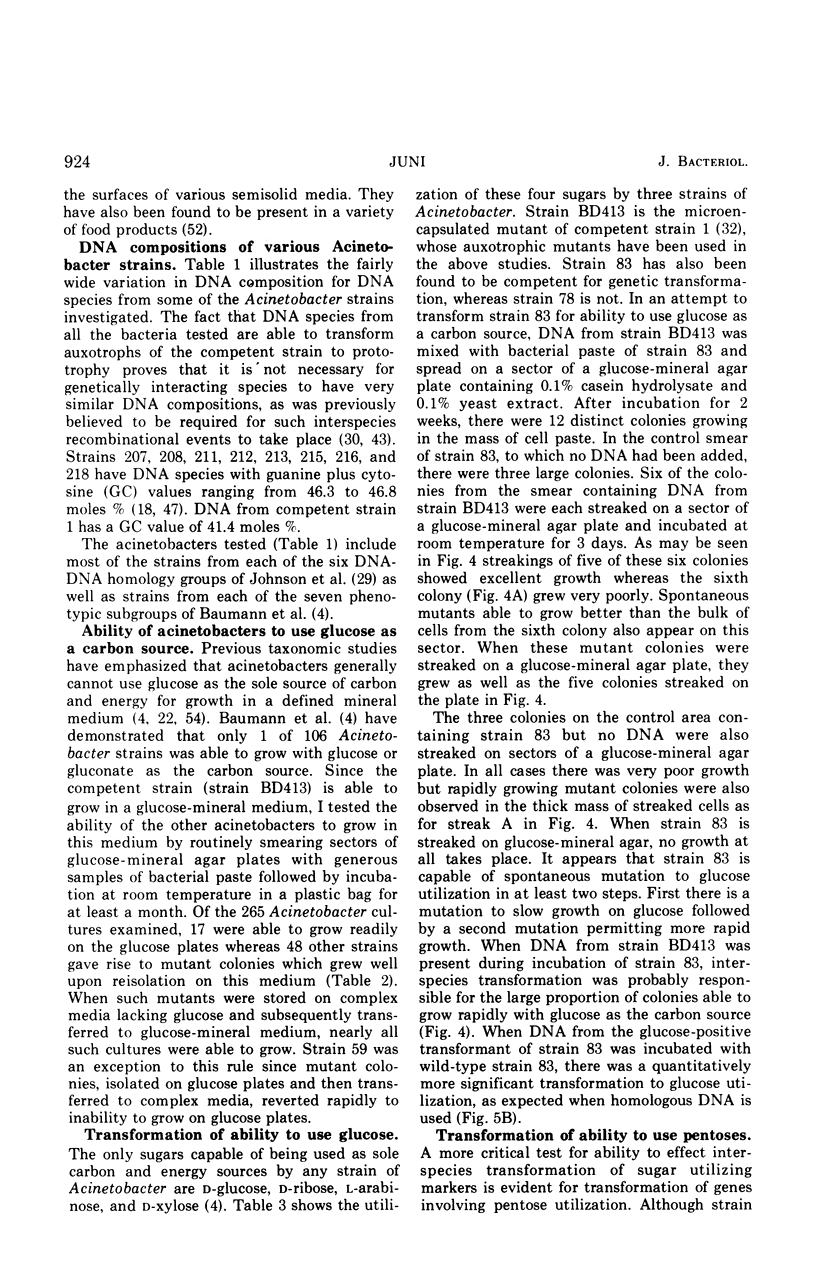
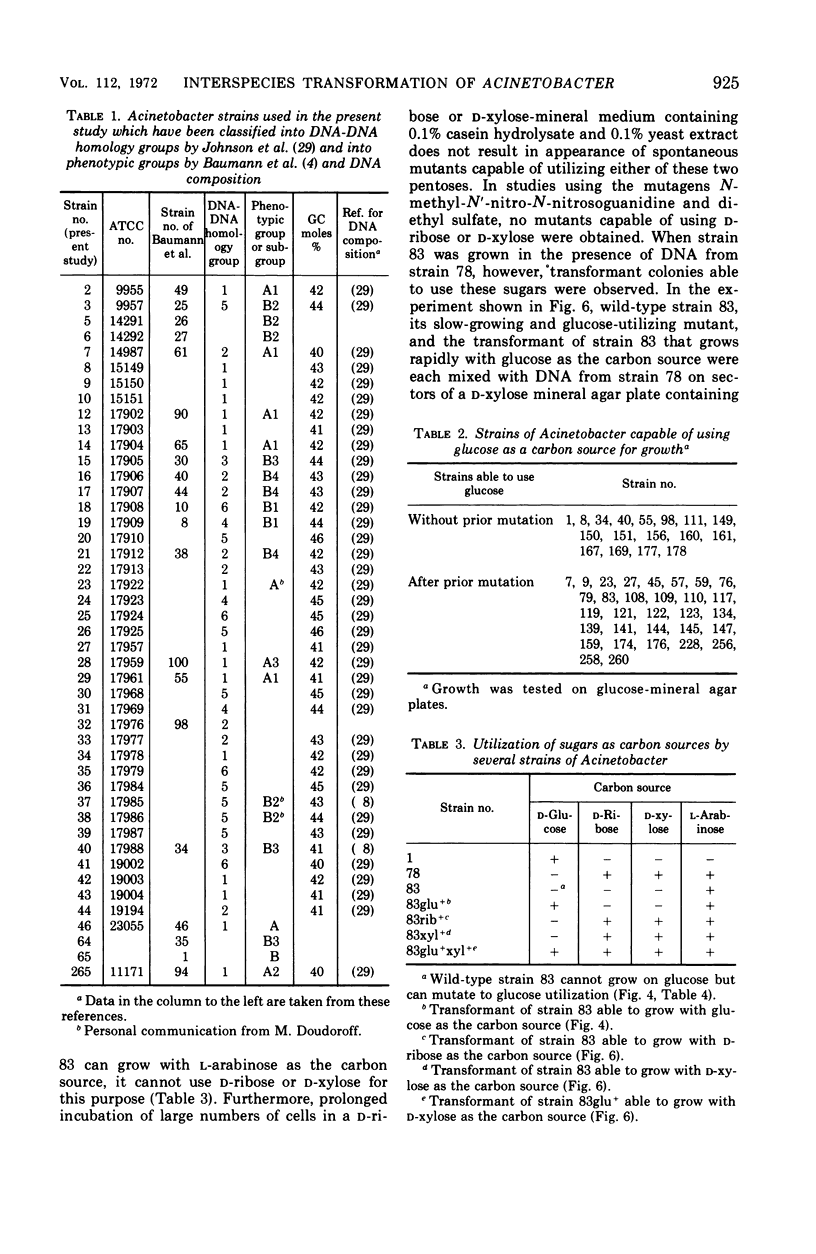
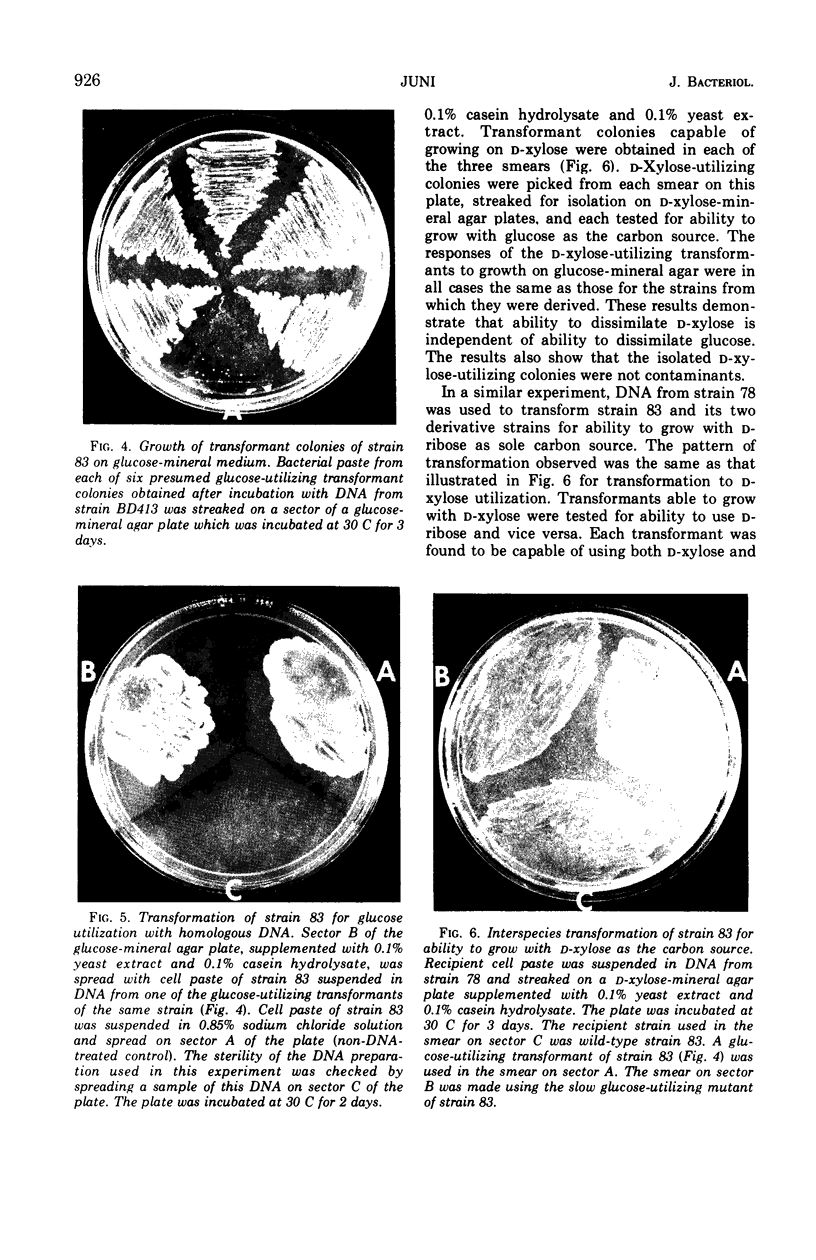
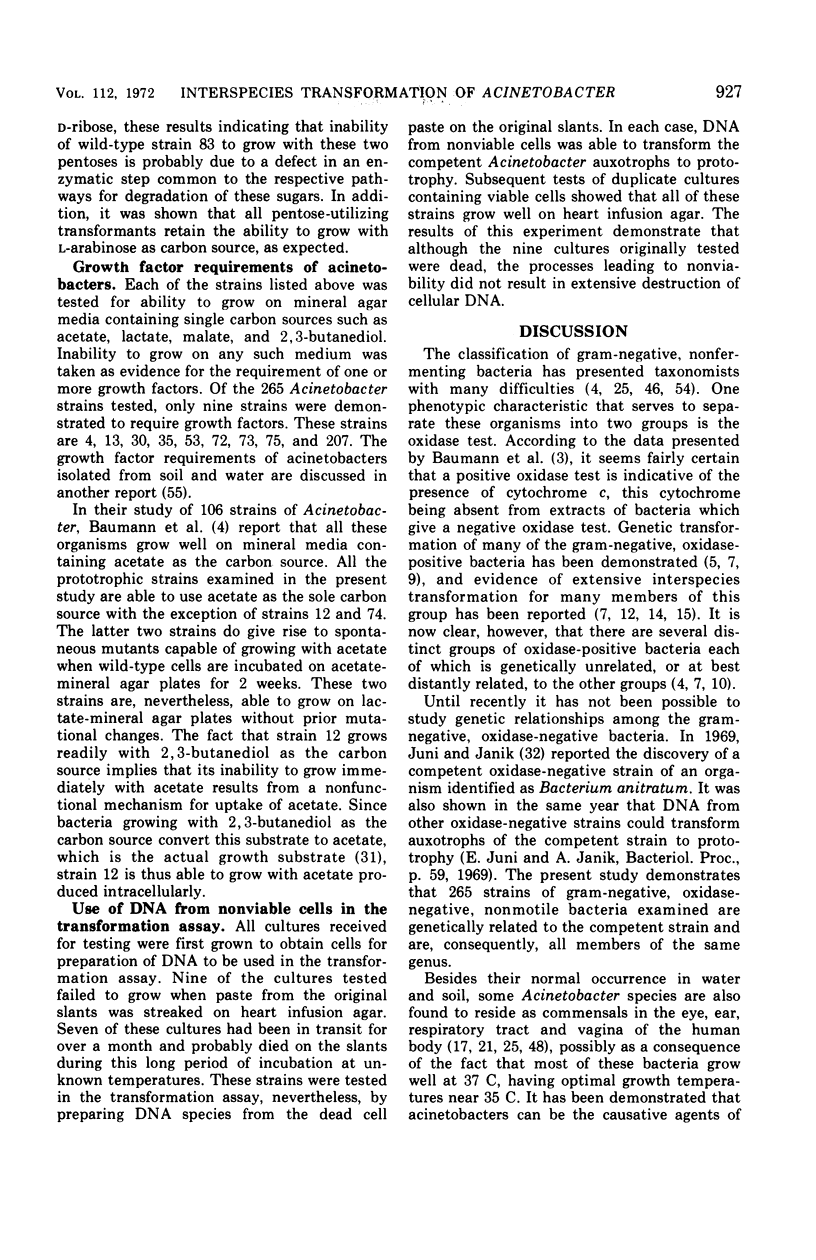
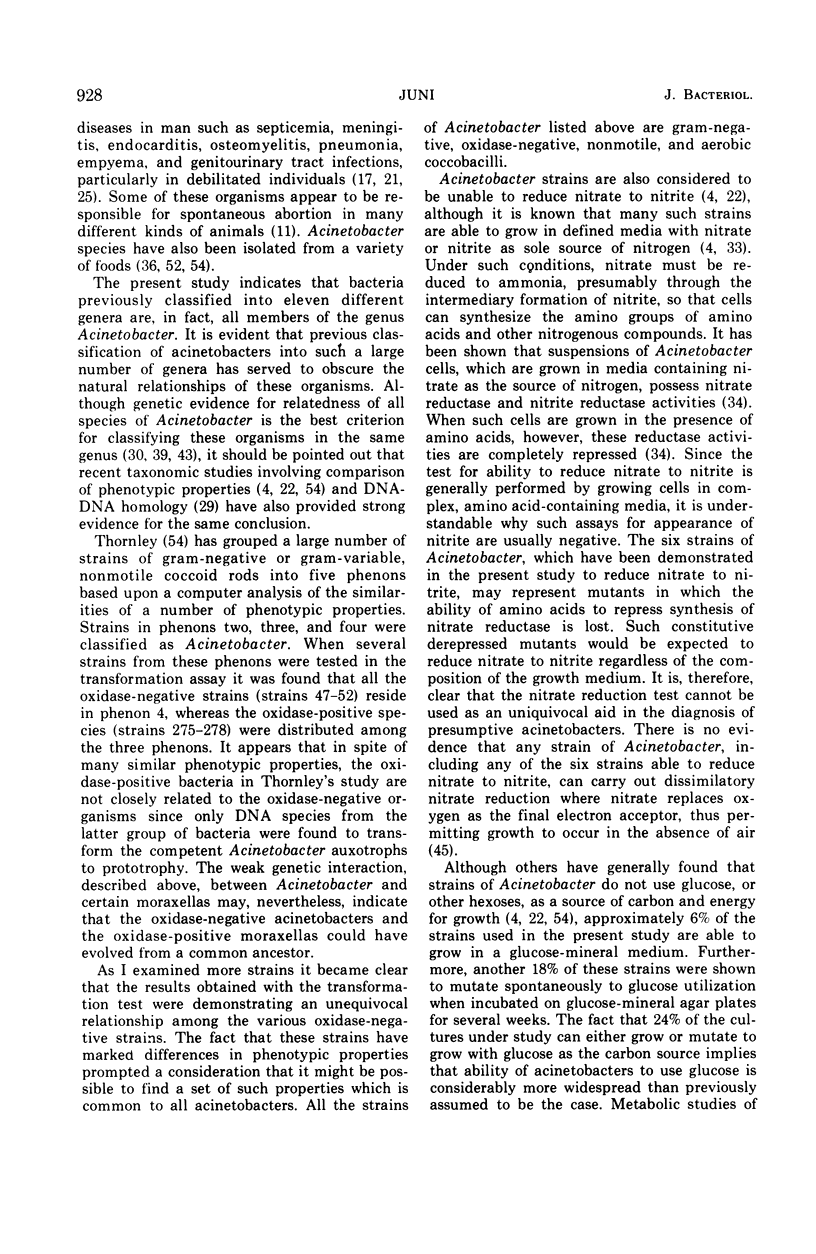
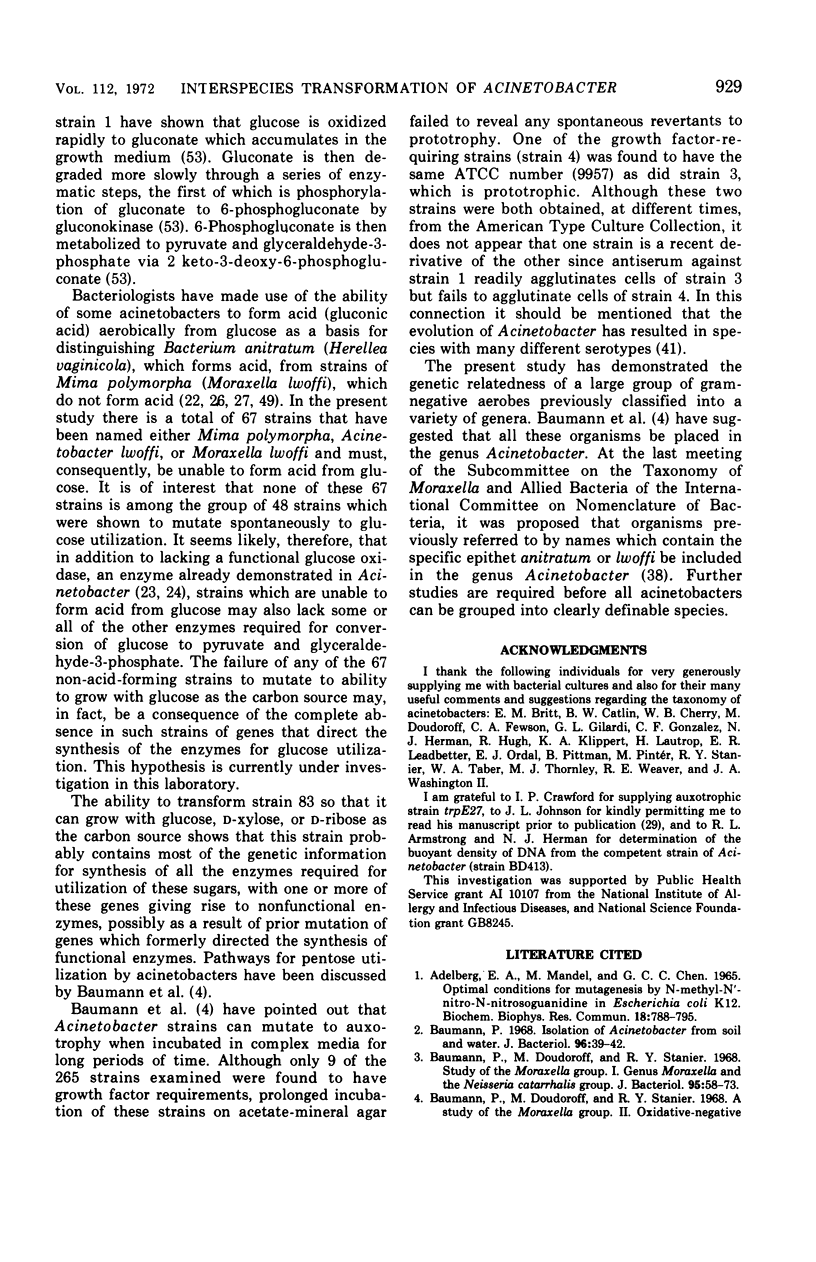
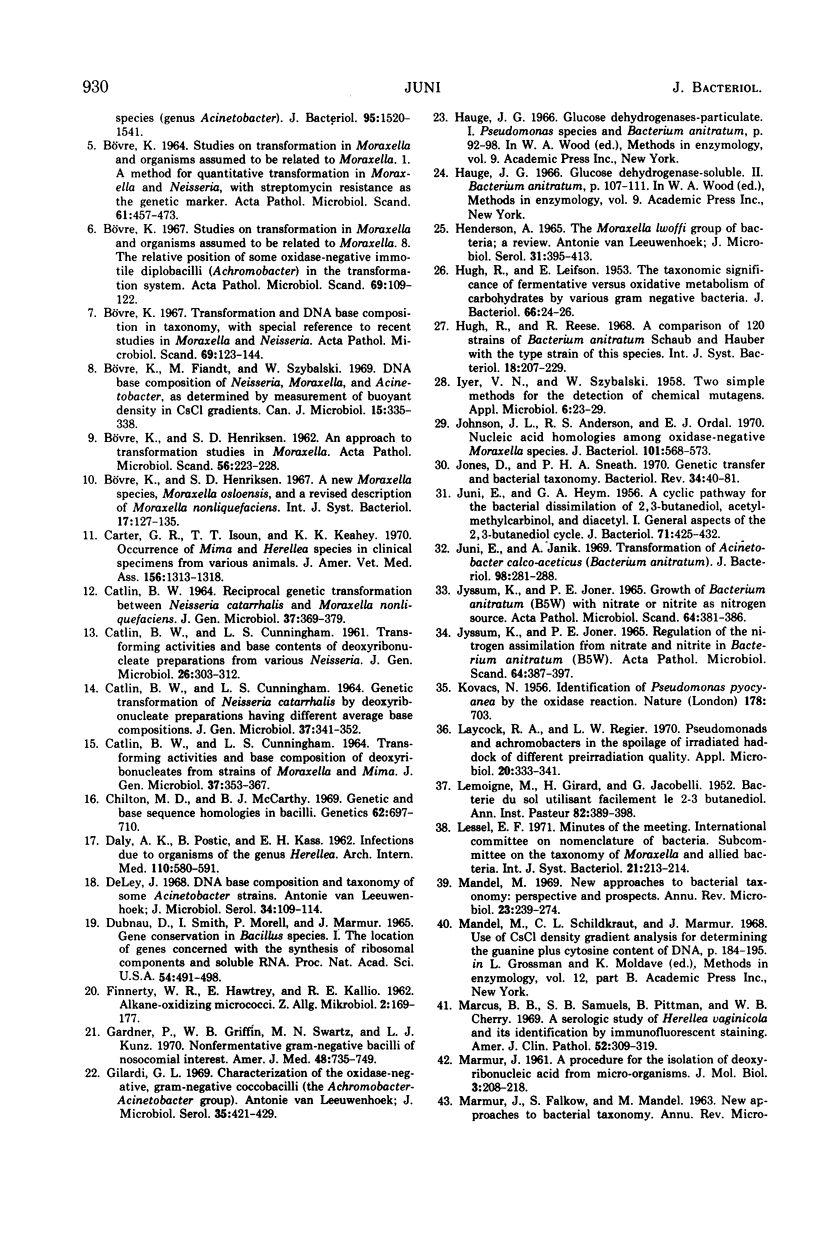
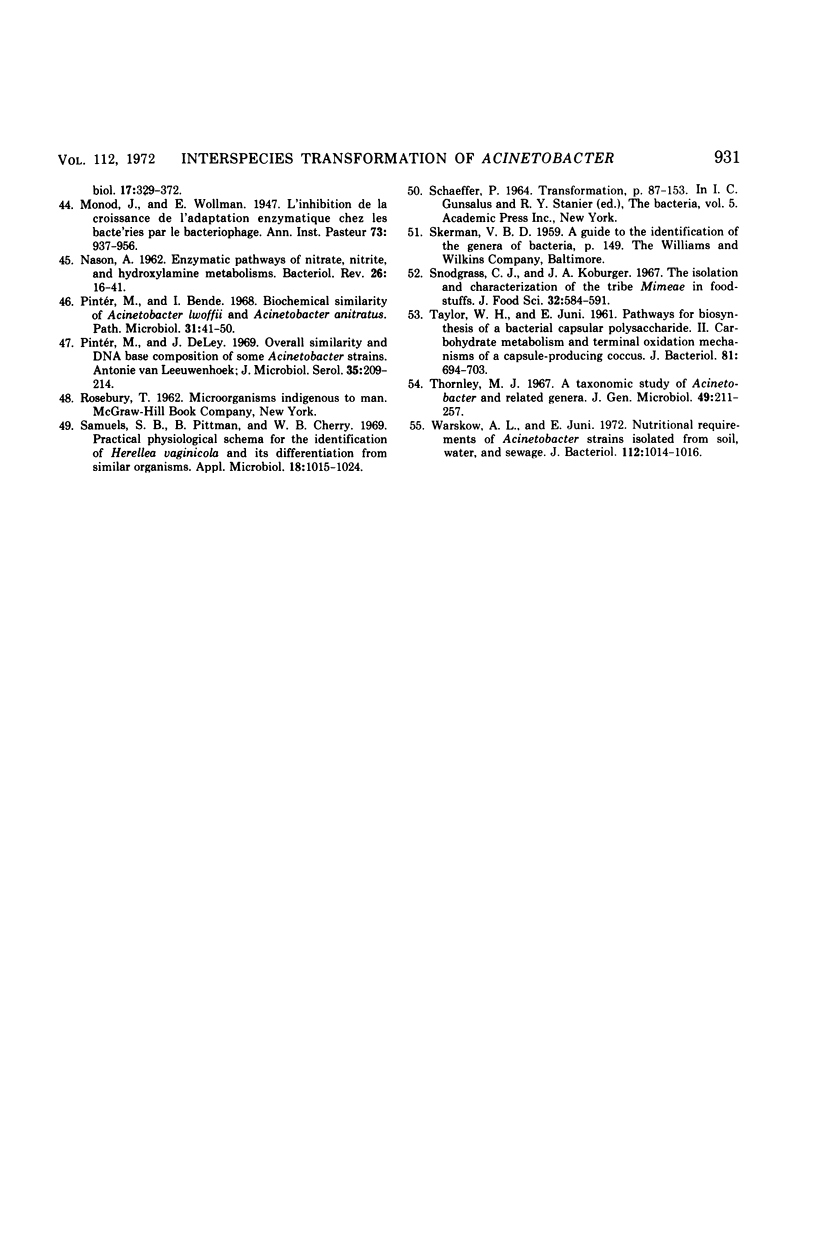
Images in this article
Selected References
These references are in PubMed. This may not be the complete list of references from this article.
- BOEVRE K. STUDIES ON TRANSFORMATION IN MORAXELLA AND ORGANISMS ASSUMED TO BE RELATED TO MORAXELLA. 1. A METHOD FOR QUANTITATIVE TRANSFORMATION IN MORAXELLA AND NEISSERIA, WITH STREPLOMYCIN RESISTANCE AS THE GENETIC MARKER. Acta Pathol Microbiol Scand. 1964;61:457–473. doi: 10.1111/apm.1964.61.3.457. [DOI] [PubMed] [Google Scholar]
- BOVRE K., HENRIKSEN S. D. An approach to transformation studies in Moraxella. Acta Pathol Microbiol Scand. 1962;56:223–228. doi: 10.1111/j.1699-0463.1962.tb04183.x. [DOI] [PubMed] [Google Scholar]
- Baumann P., Doudoroff M., Stanier R. Y. A study of the Moraxella group. II. Oxidative-negative species (genus Acinetobacter). J Bacteriol. 1968 May;95(5):1520–1541. doi: 10.1128/jb.95.5.1520-1541.1968. [DOI] [PMC free article] [PubMed] [Google Scholar]
- Baumann P., Doudoroff M., Stanier R. Y. Study of the Moraxella group. I. Genus Moraxella and the Neisseria catarrhalis group. J Bacteriol. 1968 Jan;95(1):58–73. doi: 10.1128/jb.95.1.58-73.1968. [DOI] [PMC free article] [PubMed] [Google Scholar]
- Baumann P. Isolation of Acinetobacter from soil and water. J Bacteriol. 1968 Jul;96(1):39–42. doi: 10.1128/jb.96.1.39-42.1968. [DOI] [PMC free article] [PubMed] [Google Scholar]
- Bovre K., Fiandt M., Szybalski W. DNA base composition of Neisseria, Moraxella, and Acinetobacter, as determined by measurement of buoyant density in CsCl gradients. Can J Microbiol. 1969 Apr;15(4):335–338. doi: 10.1139/m69-062. [DOI] [PubMed] [Google Scholar]
- CATLIN B. W., CUNNINGHAM L. S. GENETIC TRANSFORMATION OF NEISSERIA CATARRHALIS BY DEOXYRIBONUCLEATE PREPARATIONS HAVING DIFFERENT AVERAGE BASE COMPOSITIONS. J Gen Microbiol. 1964 Dec;37:341–352. doi: 10.1099/00221287-37-3-341. [DOI] [PubMed] [Google Scholar]
- CATLIN B. W., CUNNINGHAM L. S. TRANSFORMING ACTIVITIES AND BASE COMPOSITION OF DEOXYRIBONUCLEATES FROM STRAINS OF MORAXELLA AND MIMA. J Gen Microbiol. 1964 Dec;37:353–367. doi: 10.1099/00221287-37-3-353. [DOI] [PubMed] [Google Scholar]
- CATLIN B. W., CUNNINGHAM L. S. Transforming activities and base contents of deoxyribonucleate preparations from various Neisseriae. J Gen Microbiol. 1961 Oct;26:303–312. doi: 10.1099/00221287-26-2-303. [DOI] [PubMed] [Google Scholar]
- CATLIN B. W. RECIPROCAL GENETIC TRANSFORMATION BETWEEN NEISSERIA CATARRHALIS AND MORAXELLA NONLIQUEFACIENS. J Gen Microbiol. 1964 Dec;37:369–379. doi: 10.1099/00221287-37-3-369. [DOI] [PubMed] [Google Scholar]
- Carter G. R., Isoun T. T., Keahey K. K. Occurrence of Mima and Herellea species in clinical specimens from various animals. J Am Vet Med Assoc. 1970 May 1;156(9):1313–1318. [PubMed] [Google Scholar]
- Chilton M. D., McCarthy B. J. Genetic and base sequence homologies in bacillus. Genetics. 1969 Jul;62(3):697–710. [PMC free article] [PubMed] [Google Scholar]
- DALY A. K., POSTIC B., KASS E. H. Infections due to organisms of the genus Herellea. B5W and B. anitratum. Arch Intern Med. 1962 Nov;110:580–591. doi: 10.1001/archinte.1962.03620230026006. [DOI] [PubMed] [Google Scholar]
- Dubnau D., Smith I., Morell P., Marmur J. Gene conservation in Bacillus species. I. Conserved genetic and nucleic acid base sequence homologies. Proc Natl Acad Sci U S A. 1965 Aug;54(2):491–498. doi: 10.1073/pnas.54.2.491. [DOI] [PMC free article] [PubMed] [Google Scholar]
- Gardner P., Griffin W. B., Swartz M. N., Kunz L. J. Nonfermentative gram-negative bacilli of nosocomial interest. Am J Med. 1970 Jun;48(6):735–749. doi: 10.1016/s0002-9343(70)80009-2. [DOI] [PubMed] [Google Scholar]
- Gilardi G. L. Characterization of the oxidase-negative, gram-negative coccobacilli (the Achromobacter-acinetobacter group). Antonie Van Leeuwenhoek. 1969;35(4):421–429. doi: 10.1007/BF02219161. [DOI] [PubMed] [Google Scholar]
- HUGH R., LEIFSON E. The taxonomic significance of fermentative versus oxidative metabolism of carbohydrates by various gram negative bacteria. J Bacteriol. 1953 Jul;66(1):24–26. doi: 10.1128/jb.66.1.24-26.1953. [DOI] [PMC free article] [PubMed] [Google Scholar]
- Henderson A. The Moraxella iwoffi group of bacteria; a review. Antonie Van Leeuwenhoek. 1965;31(4):395–413. doi: 10.1007/BF02045919. [DOI] [PubMed] [Google Scholar]
- IYER V. N., SZYBALSKI W. Two simple methods for the detection of chemical mutagens. Appl Microbiol. 1958 Jan;6(1):23–29. doi: 10.1128/am.6.1.23-29.1958. [DOI] [PMC free article] [PubMed] [Google Scholar]
- JUNI E., HEYM G. A. A cyclic pathway for the bacterial dissimilation of 2, 3-butanediol, acetylmethylcarbinol, and diacetyl. I. General aspects of the 2, 3-butanediol cycle. J Bacteriol. 1956 Apr;71(4):425–432. doi: 10.1128/jb.71.4.425-432.1956. [DOI] [PMC free article] [PubMed] [Google Scholar]
- Johnson J. L., Anderson R. S., Ordal E. J. Nucleic acid homologies among oxidase-negative Moraxella species. J Bacteriol. 1970 Feb;101(2):568–573. doi: 10.1128/jb.101.2.568-573.1970. [DOI] [PMC free article] [PubMed] [Google Scholar]
- Jones D., Sneath P. H. Genetic transfer and bacterial taxonomy. Bacteriol Rev. 1970 Mar;34(1):40–81. doi: 10.1128/br.34.1.40-81.1970. [DOI] [PMC free article] [PubMed] [Google Scholar]
- Juni E., Janik A. Transformation of Acinetobacter calco-aceticus (Bacterium anitratum). J Bacteriol. 1969 Apr;98(1):281–288. doi: 10.1128/jb.98.1.281-288.1969. [DOI] [PMC free article] [PubMed] [Google Scholar]
- Jyssum K., Joner P. E. Growth of Bacterium anitratum (B5W) with nitrate or nitrite as nitrogen source. Acta Pathol Microbiol Scand. 1965;64(3):381–386. doi: 10.1111/apm.1965.64.3.381. [DOI] [PubMed] [Google Scholar]
- Jyssum K., Joner P. E. Regulation of the nitrogen assimilation from nitrate and nitrite in Bacterium anitratum (B5W). Acta Pathol Microbiol Scand. 1965;64(3):387–397. doi: 10.1111/apm.1965.64.3.387. [DOI] [PubMed] [Google Scholar]
- KOVACS N. Identification of Pseudomonas pyocyanea by the oxidase reaction. Nature. 1956 Sep 29;178(4535):703–703. doi: 10.1038/178703a0. [DOI] [PubMed] [Google Scholar]
- LEMOIGNE M., GIRARD H., JACOBELLI G. Bactérie du sol utilisant facilement le 2-3 butanediol. Ann Inst Pasteur (Paris) 1952 Apr;82(4):389–398. [PubMed] [Google Scholar]
- Laycock R. A., Regier L. W. Pseudomonads and achromobacters in the spoilage of irradiated haddock of different preirradiation quality. Appl Microbiol. 1970 Sep;20(3):333–341. doi: 10.1128/am.20.3.333-341.1970. [DOI] [PMC free article] [PubMed] [Google Scholar]
- Mandel M. New approaches to bacterial taxonomy: perspective and prospects. Annu Rev Microbiol. 1969;23:239–274. doi: 10.1146/annurev.mi.23.100169.001323. [DOI] [PubMed] [Google Scholar]
- Marcus B. B., Samuels S. B., Pittman B., Cherry W. B. A serologic study of Herellea vaginicola and its identification by immunofluorescent staining. Am J Clin Pathol. 1969 Sep;52(3):309–319. doi: 10.1093/ajcp/52.3.309. [DOI] [PubMed] [Google Scholar]
- NASON A. Symposium on metabolism of inorganic compounds. II. Enzymatic pathways of nitrate, nitrite, and hydroxylamine metabolisms. Bacteriol Rev. 1962 Mar;26:16–41. doi: 10.1128/br.26.1.16-41.1962. [DOI] [PMC free article] [PubMed] [Google Scholar]
- Pintér M., Bende I. Biochemical similarity of Acinetobacter lwoffii and Acinetobacter anitratus. Pathol Microbiol (Basel) 1968;31(1):41–45. [PubMed] [Google Scholar]
- Pintér M., De Ley J. Overall similarity and DNA base composition of some Acinetobacter strains. Antonie Van Leeuwenhoek. 1969;35(2):209–214. doi: 10.1007/BF02219131. [DOI] [PubMed] [Google Scholar]
- Samuels S. B., Pittman B., Cherry W. B. Practical physiological schema for the identification of Herellea vaginicola and its differentiation from similar organisms. Appl Microbiol. 1969 Dec;18(6):1015–1024. doi: 10.1128/am.18.6.1015-1024.1969. [DOI] [PMC free article] [PubMed] [Google Scholar]
- TAYLOR W. H., JUNI E. Pathways for biosynthesis of a bacterial capsular polysaccharide. I. Carbohydrate metabolism and terminal oxidation mechanisms of a capsuleproducing coccus. J Bacteriol. 1961 May;81:694–703. doi: 10.1128/jb.81.5.694-703.1961. [DOI] [PMC free article] [PubMed] [Google Scholar]
- Thornley M. J. A taxonomic study of Acinetobacter and related genera. J Gen Microbiol. 1967 Nov;49(2):211–257. doi: 10.1099/00221287-49-2-211. [DOI] [PubMed] [Google Scholar]
- Warskow A. L., Juni E. Nutritional requirements of Acinetobacter strains isolated from soil, water, and sewage. J Bacteriol. 1972 Nov;112(2):1014–1016. doi: 10.1128/jb.112.2.1014-1016.1972. [DOI] [PMC free article] [PubMed] [Google Scholar]




